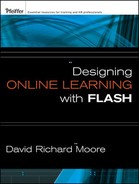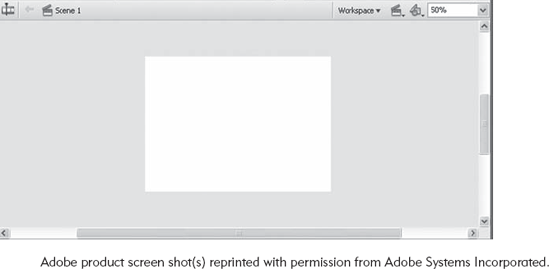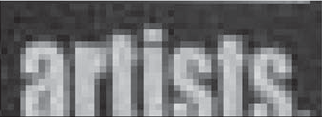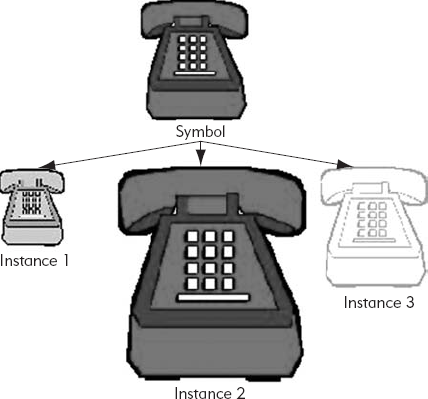Guiding Questions
What is Flash?
Why is Flash ideal for a practice-centric instruction?
What is ActionScript?
How does Flash interact with other programs?
How can you distribute Flash applications?
What metaphor does Flash use?
Why is Flash ideal for web distribution?
How does Flash animate?
What is the principle of reuse?
In this chapter I will review the Flash software and describe why it is the most appropriate software instructional software applications. The strengths and weaknesses of Flash will be explored, and the software will be compared and contrasted with competing alternatives. After reading this chapter, you will understand how Flash can play a prominent role in online learning.
Flash is a multimedia authoring system produced by Adobe Systems. Flash was formerly a Macromedia product; however, Adobe Systems merged with Macromedia in 2005 and has brought Flash into its family of software.
The name Flash refers to the player, as well as to the application development environment. The player and development environment are distinct entities. The application development environment is the software that allows you to create Flash applications. Flash applications can be published as .swf files, which can be distributed over the Internet. The Flash player is required to view these .swf files. The player is available for free to anyone. To work through the examples provided in this text, you will need to have access to the Flash Application Development Environment. This software is not free, although Adobe Systems does offer a thirty-day free trail, which can be downloaded at www.adobe.com/downloads/.
As Flash has developed, a number of versions have been produced. This text uses the CS3 Professional version. However, all of the features demonstrated should work if you are using Flash Version 8.
Flash was originally developed as a tool for online animation. It was designed to use the power of the computer to interpolate a series of images between two graphics, creating the illusion of motion without forcing the user to create each step or cell of an animated display as in Figure 5.1.
This ability is a huge bandwidth saver and has helped make Flash one of the most ubiquitous tools on the Internet. Flash enhances html and other web delivery standards by making it easy to deliver robust content over the Internet while using relatively little bandwidth. However, Flash is no longer merely an animation tool; it has evolved into a comprehensive interactive multimedia tool that is as powerful and flexible as any multimedia development platform available.
Flash uses a timeline and stage metaphor. The timeline in Figure 5.2 moves from left to right. Any object placed on the timeline will appear on the stage until it is removed.
In the same way, any object placed on the stage, as shown in Figure 5.3, will be indicated on the timeline until it is removed.
Flash has enhanced its animation capabilities with powerful programming and interaction tools. Flash's scripting language, ActionScript, is a robust and well-developed language, which provides a solid platform for programmers. ActionScript works well with technologies such as PHP, which allows actions within a Flash application to be recorded in online databases. Database connections allow the learners' actions to be tracked and documented.
Although this book does not focus on programming, there are times when short pieces of ActionScript are helpful. ActionScript allows the interactivity to be introduced into Flash through the implementation of variable, conditional statement, loops, and functions. ActionScript is similar to JavaScript in syntax and experienced JavaScript users should not have trouble using it.
There are now two versions of ActionScript that are widely used: ActionScript 2.0 and ActionScript 3.0. There are similarities between the two versions, but there are also substantial differences in syntax. In this text, ActionScript 2.0 will be used because it is applicable to Flash 8, as well as Flash CS3. If you are using Flash CS3, be sure to select ActionScript 2.0 when you work through the Flash guides.
For the non-programmer, or for the programmer who has other things to do, Flash offers a comprehensive set of pre-built components that provide capabilities such as learning interactions that can be tailored to one's specific needs. For example, Flash comes with a set of "learning interactions" that allow the developer to create test questions such as multiple choice, true/false, and drag and drop. These components do not require any programming, which makes them easy to use regardless of one's experience level.
The software for developing Flash modules is organized in such a way as to make it accessible to the novice developer, while its capabilities are powerful enough to accommodate programmers and multimedia experts. In addition to allowing programming through ActionScript, Flash can incorporate sound, video, and other multimedia. Flash can display media in a number of forms and formats, including QuickTime, WAV, AVI, and many more. Figure 5.4 presents the types of format that are acceptable for Flash.
Flash's ease and power make it the tool of choice for implementing instructional software. Of particular importance to online learning developers is that the Flash player can read Flash files on just about any operating system (Mac, PC, and Linux) with just about any web browser (Firefox, Internet Explorer, and Opera). Flash is perhaps the most ubiquitous application on the Internet, being accessible to over 99 percent of Internet users. Flash's ubiquity also enhances its consistency. With Flash, developers can be confident that they can provide the same user experience to every online learner. This standardization enormously increases the efficiency of online learning development.
Flash files come in two forms .fla that can continue to be edited by the authoring environment and .swf that can be placed on a common web server for distribution over the Internet. Flash files can also be turned into independently executable .exe files that can be distributed on a CD-ROM and can be run directly on the user's computer.
Not only is the Flash player widely available to users, but developers can distribute Flash files can be done easily by hosting the Flash files on any standard web server (a computer whose function is to serve web pages to users). Distributing Flash files is as easy as distributing a web page. Flash can be easily viewed, easily distributed, and as you will see, it is an easy environment in which to develop applications. Those attributes make it an ideal platform for online learning.
The Internet is the medium in which online learning is delivered. The Internet is designed in such a way that users with varying types of bandwidth connections can participate, although with faster or slower results. As an online learning developer, you may have learners with high-speed broadband access, and you may have learners with more modest connections. The implication is that reducing bandwidth is an important consideration so that all of your learners have a similar experience.
Fortunately, Flash is designed to minimize bandwidth consumption on a number of fronts. Flash is primarily a vector-based program, which reduces file size considerably. Flash is also designed on an object-oriented model, which allows for the reuse of elements within Flash at little or no extra cost in bandwidth. In fact, Flash has a system for storing the objects that it uses on the client's system so they do not have to be reloaded to play; the result is a significant savings in bandwidth.
Bandwidth can be minimized in Flash through three primary methods: (1) reduce, (2) reuse, and (3) recycle. Graphics used within Flash can be reduced by transforming them into vector graphics. Flash handles both vector and raster graphic types. Raster graphics are images that are displayed through a collection of individual pixels. Photographic-type images are almost exclusively of this type. File formats such as .gif and .jpg are common raster formats. Figure 5.5 is an example of a raster-based graphic.
Flash also handles vector graphics; in fact, Flash prefers vector graphics because they require dramatically less bandwidth to deliver. Vector graphics are described by mathematical equations that define a series of points, lines, and shapes. For example, a rectangle can be described by its position on the screen and its height and width. Figure 5.4 is an example of a vector-based graphic.
Vector graphics have the added advantage of their size being infinitely manipulatable without losing resolution or requiring additional bandwidth. They can be rotated, enlarged, and twisted while keeping their resolution. For example, in Figure 5.5, the image has become pixilated when its size was increased; however, Figure 5.6 has remained clear. There are some graphics that work best as raster graphics and others that can be converted to the vector type without losing the intended message. So whenever possible when using Flash, convert graphic files to the vector type.
Bandwidth can also be minimized through the principle of reuse. Flash has elements called "symbols" that allow graphics (and other elements) to be reused. Normally, when a graphic is copied and pasted, two separate copies now exist. With symbols, a graphic does not need to be copied. Instead, it is instantiated. This means that the instances share the properties of the original but are not copies; if you change the original symbol, the instances will also be changed. This process is demonstrated in Figure 5.7.
Finally, graphics can be recycled by modifying symbols. For example, some properties, such as size, can be modified in an instance without affecting the original symbol. In Figure 5.8, you can see how a symbol can be recycled.
Finally, Flash uses a feature called progressive download. Progressive download allows you so manipulate bandwidth by using a bit of choreography (Moore & Lockee, 2000). Flash begins to download and present material to the learner as it arrives. That way the learner can instantly begin to interact with the software. By placing some low bandwidth items early in the application, such as text and vector graphics, the system can continue to download external files such as video without the learners having to wait. The result is that the same amount of data is transferred, but the learners can begin using the application instantly.
From the instructional side, Flash offers you the ability to create online learning applications that are ideally suited for creating a quality learner experience. Learners can:
Repeat the application endlessly
Go at their own pace
Receive immediate feedback
Keep track of their progress
Participate when and where their schedule allows
These capabilities make Flash an ideal environment for learning from both a technical and an instructional standpoint.
The Flash guides included in this text cover the major features of Flash's Integrated Development Environment. These features include:
Panels and interface
Drawing and graphic tools
Layers and timeline
Basic animation
Buttons and interactivity
Scripting basics
Movie clips and symbols
Complex animation
Multimedia








